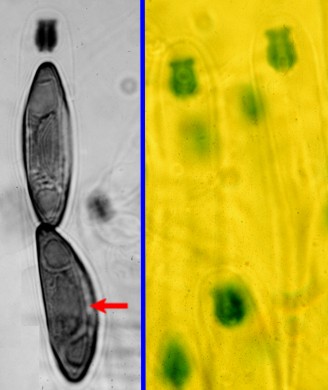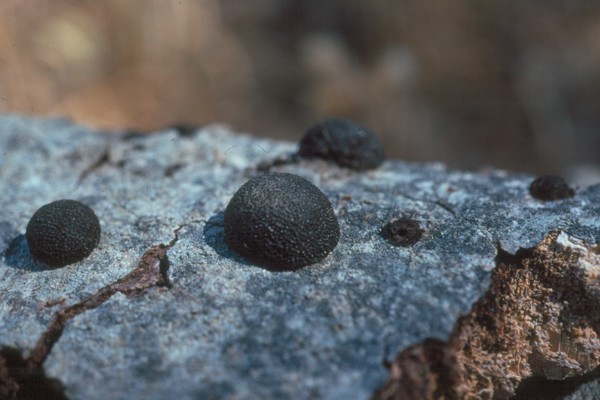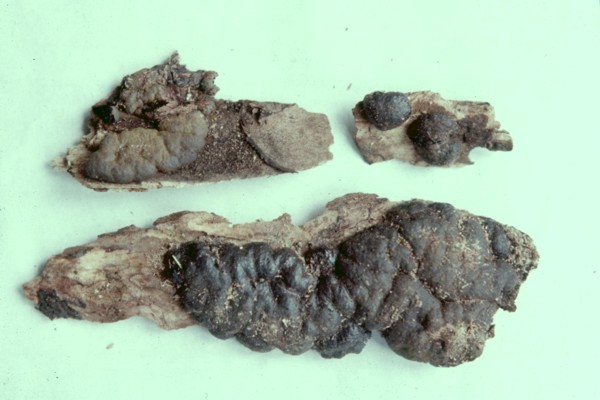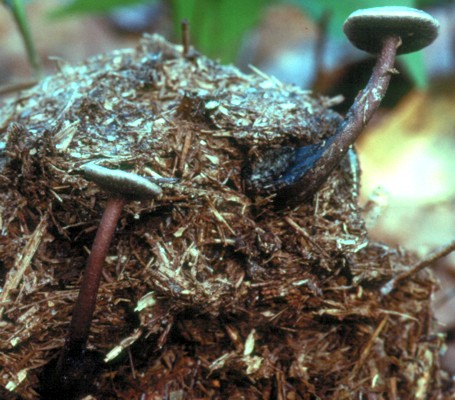Home >> Diversity and classification >> True fungi >> Dikarya >> Ascomycota >> Pyrenomycetes >> Sordariomycetes >> Xylariomycetidae
THE XYLARIOMYCETIDAE
The Xylariomycetidae form the smallest of the three subclasses of Sordariomycetes but are nevertheless a group all collectors will encounter. Many have massive stromata and are highly conspicuous, dominating the surface of decaying plants.
The most frequently collected members of the Xylariomycetidae are the Xylariaceae, a family that is abundant throughout the world from the tropics to the colder regions.
 They are characterized by their often massive stromata, asci with prominent apical structures and dark brown ascospores that germinate through an elongated slit. The ascal pore is especially interesting in the Xylariaceae because it is often amyloid in Melzer's Solution, a preparation containing dissolved iodine. In the amyloid reaction a structure that is normally pale or colourless turns various shades of blue. Not all of the Xylariaceae have amyloid ascal pores; some are dextrinoid and change to a dark reddish colour while others seem to have not reaction to iodine at all. However these reactions are generally constant within a species and are thus useful for identification. Asci in the pictures at left are from a collection of Ustulina deusta, a common species in our forests. They were photographed in Melzer's solution to show the large amyloid ascal pores. In the black and white panel at far left there are two of the eight ascospores showing as well as the pore. The lower one of these spores shows the germination slit running from end to end, indicated by a red arrow. The right panel shows several asci and the blue amyloid reaction of their apical pores.
They are characterized by their often massive stromata, asci with prominent apical structures and dark brown ascospores that germinate through an elongated slit. The ascal pore is especially interesting in the Xylariaceae because it is often amyloid in Melzer's Solution, a preparation containing dissolved iodine. In the amyloid reaction a structure that is normally pale or colourless turns various shades of blue. Not all of the Xylariaceae have amyloid ascal pores; some are dextrinoid and change to a dark reddish colour while others seem to have not reaction to iodine at all. However these reactions are generally constant within a species and are thus useful for identification. Asci in the pictures at left are from a collection of Ustulina deusta, a common species in our forests. They were photographed in Melzer's solution to show the large amyloid ascal pores. In the black and white panel at far left there are two of the eight ascospores showing as well as the pore. The lower one of these spores shows the germination slit running from end to end, indicated by a red arrow. The right panel shows several asci and the blue amyloid reaction of their apical pores.


The stromata of Pyrenomyxa picea shown in the picture at right are examples of the kind of spreading growth shown by this species and many species of the genus Hypoxylon. The perithecia are united within the stroma and will only be seen by cutting through it. Some species. such as Daldinia grandis at far right, produce more sharply delimited stromata that can become hemispherical. The rough surface seen in the photo of D. grandis is caused by the protruding ostioles of the perithecia.

Species of the genus Xylaria, pictured above, produce upright stromata that may become highly branched. Xylaria polymorpha, in the left panel, is a common species in our region that produces irregular club-shaped stromata bearing perithecia beneath most of their surface. These strange-looking stromata are called "dead men's fingers" by many people.
 The unidentified species in the middle panel is not mature but is bearing numerous white conidia (asexual spores) at the ends of its branches. This species was growing among fallen branches in a redwood forest in California. Xylaria magnoliae in the right panel also produces narrow stromata, with the perithecia concentrated in the lower and middle areas. It specializes in growing on the fallen inflorescences of magnolia trees.
The unidentified species in the middle panel is not mature but is bearing numerous white conidia (asexual spores) at the ends of its branches. This species was growing among fallen branches in a redwood forest in California. Xylaria magnoliae in the right panel also produces narrow stromata, with the perithecia concentrated in the lower and middle areas. It specializes in growing on the fallen inflorescences of magnolia trees.
Members of the genus Poronia, such as P. punctata pictured at left, grow on old dung. They produce stromata that resemble small mushrooms or tacks. The perithecia are produced on the upper part so that their ostioles protrude through the top of the tack.

The Diatrypaceae is another interesting group of Xylariomycetidae. In many ways they resemble less elaborate Xylariaceae such as many species of Hypoxylon. Like the Xylariaceae the Diatrypaceae produce massive stromata with perithecia below their surface. The fairly large perithecia have asci and paraphyses lining their inner walls. Although their asci do not have the large amyloid or dextrinoid plugs characteristic of the Xylariaceae there is definitely a well-defined ascal plug. The most conspicuous difference is in the ascospores. While the Xylariaceae have mostly large and nearly black ascospores with germination slits, those of the Diatrypaceae are brown and allantoid (sausage-shaped). Pictured above is Diatrype baccharidis, a fairly typical member of the Diatrypaceae. The left panel shows the stromata of this species as they occur on dead branches of Baccharis pilularis. The next shows a cross section through the stromata. The stroma has a nearly black "rind" and an white inner part. The thin perithecial wall is darker brown than the surrounding tissues of the stroma. The two right panels show asci and the typical allantoid ascospores. The Diatrypaceae are very common on dead woody plants and can be collected throughout the year.